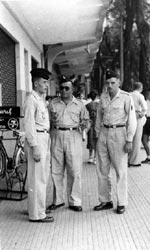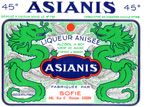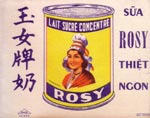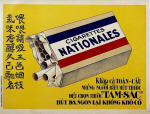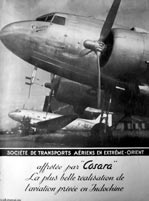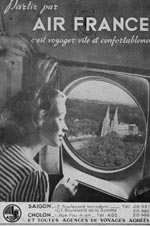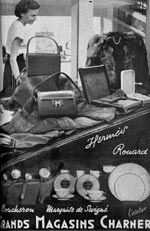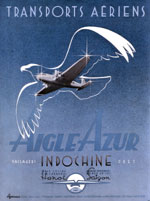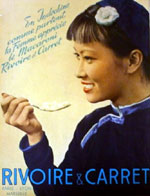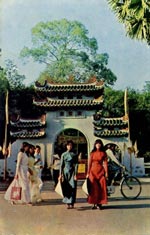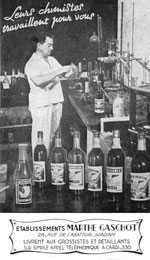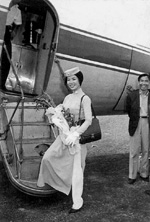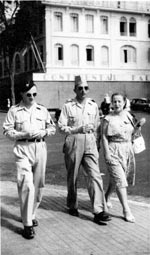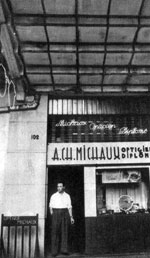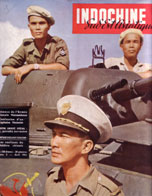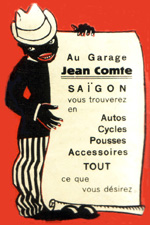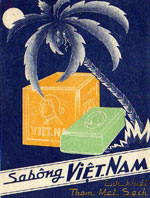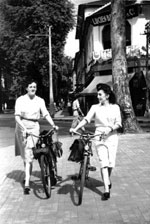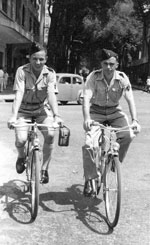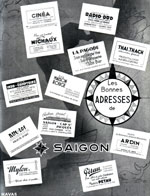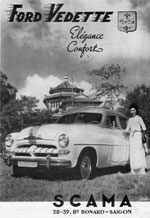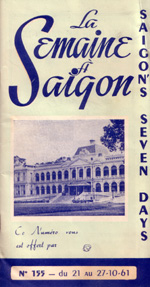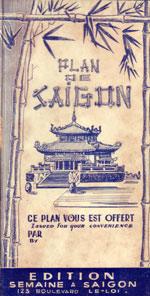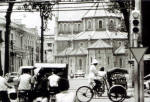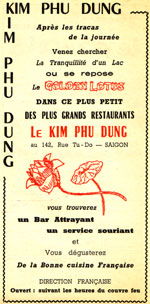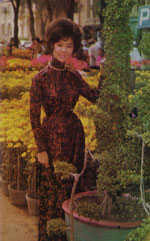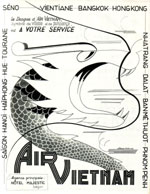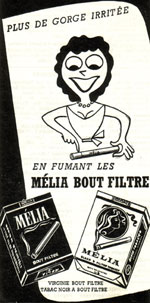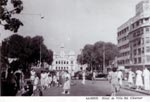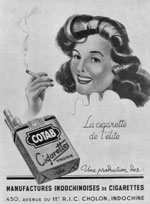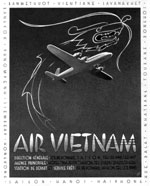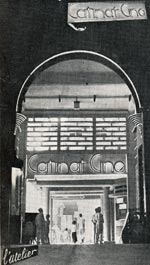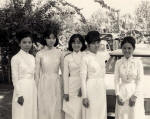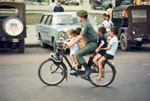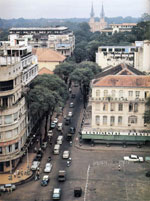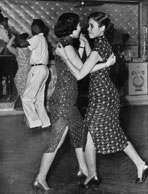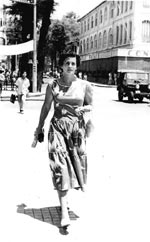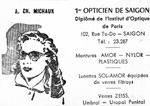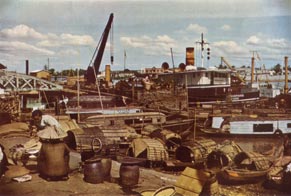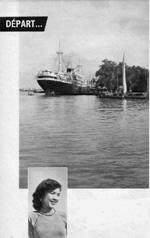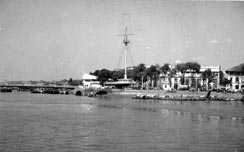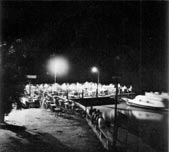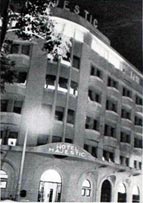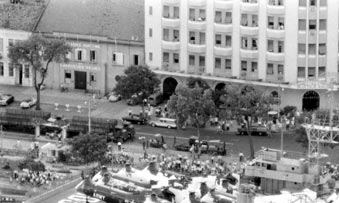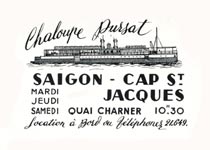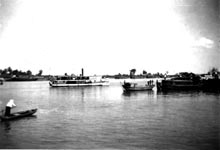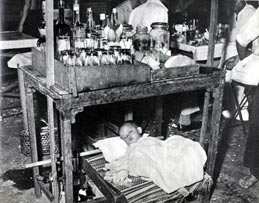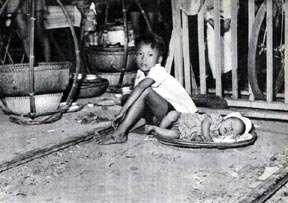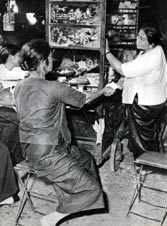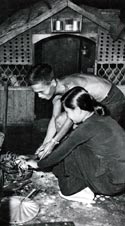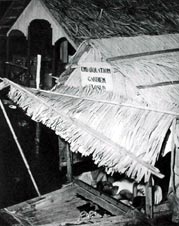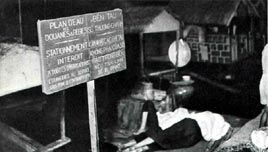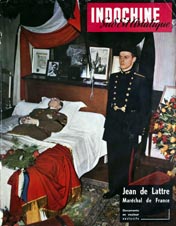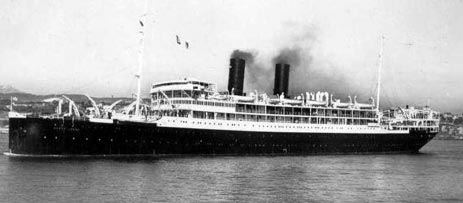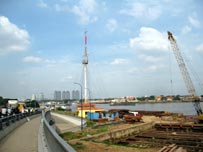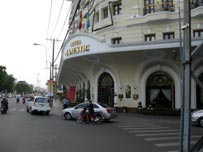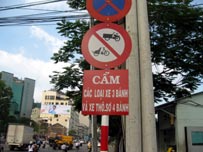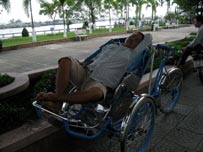

Harbor Cafes in 1952
by Bruno Rajan
At night in Saigon, three hundred meters of dock, three hundred meters of Asia.
The Myre de Villers Dock ( BĂŞn Bach DĂ ng in 1955, now TĂ´n Duc Thang).
Around 6 p.m., the Saigon docks change: little by little, by way of land and the river, sellers of all sorts of things pour in.
At night in Saigon, Jokers Point, as its name implies, is a little piece of France. An open-air café protrudes onto the rounded breakwater at the confluence of the River and the Chinese Arroyo. That’s where one gets the best view of the steamships and the best breezes.
The Jokers Point Cafe
The Jokers Point Cafe is located at the end of the Belgium Dock across from the Descours & Cabaud office, and the Chinese Arroyo separates it from the Messageries Maritimes dock.
The old Saigonese prefer this single-level terrace of the Yacht Club: they get the feeling of staying home at night in an increasingly hostile country, as well as the impression that they can return to France whenever they like. In the meantime, they listen to the tides from afar, lapping capriciously at the rocks, and the sampanier (flat-bottomed boat driver) seller of Chinese soup, singing the praises of his cooking to the paddy junks, that the water level has trapped for the night near the Khanh Hoi bridge.
Seated on this breakwater abandoned by shipping, the old Saigonese watch the "André Lebon": there are a lot of old things that grew old together (*).
The Hotel Majestic
From the terrace of the “Majestic” one looks out over the river and the problems of Asia from on high.
On the Myre de Villers dock (in 1955 Bên Bach Dà ng, now Tôn Duc Thang), 300 meters from Joker’s Point, the Hotel Majestic is already an American citadel: because it is the most expensive hotel, the only one where there is sometimes space. The bay-windowed restaurant on the top floor overlooks the river and the other bank. It’s a place for people who will not establish roots in this country, who prefer to look out over its problems, its dangers and its germs. It’s a fortress for whites who will always stay white like the enamel of their bathtub and artificial light.
Between old Colonial France and the New World, Asia spreads out over 300 meters. Asia, a prodigious mix of people who work, play, sleep, and eat, of naked children and blind old people; teeming Asia, which hasn’t teemed this much since the war with its peace zones where refugees flock. The Asia of medieval beggars, and big chromed motorcycles whose owners are homeless; the prodigious Asia which has never offered up so many contrasts as in this end of the white man’s reign: the white man whose fruit one spits out at the moment of swallowing it – mechanical civilization…
One must see the Myre de Villers dock by day to see how much nighttime transforms it.
By day it’s a normal dock which serves for loading and unloading. Gravel from Phnom-Penh comes out of large black junks in baskets on the head of coolies under the gaze of the corporals; the train that runs on the dock off loads timber from the forests of Bien Hoa and Thu-Dau-mot at the same location; passengers board the Cap Saint-Jacques launch.
The Cape Saint-Jacques Launch
The other night life
Around 6 p.m. the other life begins.
The train returns, wheezing and gurgling, by way of the Somme Boulevard (now Hà m Nghi), dropping off a few cars in its retreat to get back to the Railroad Station located at Eugène Cuniac Square (Diên Hong) neat the Central Marketplace (Ben Thanh). .
Little by little, from dry land and from the river, come sellers of everything; the spread their wares between the water and the street, in between the rails.
The dinner hour
On the right: The syrup-seller has her maternal pride: the “nho” sleeps under the shaky table, but its head rests on a skillfully embroidered pillow.
On the left: The night life has taken over the tracks of the little train which brings in precious woods from Thudaumot and BienhoĂ every morning. And every evening a bicycle garage for night-owls takes over the tracks with impunity. The child watches over the infant and, for a Piaster, bicycles- bread-winner and family obligation.
There are mobile kitchens of all categories : the most luxurious have painted mirrors; there are sugar-cane presses with their wheels like a ship’s wheel; there are shoe-shiners and fortune-tellers; there are peanut-sellers and a portable cinema on bicycles with Charlie Chaplin and Sheriff stories; there are also cigarette-sellers; there are sellers of tripe, bunches of shrimp, shredded mandarin fish, pig-ears in strips, and smoked squid with its faded ribbons; there are agar-agar sellers (a gelatinous substance made from red algae), lychees, lotus seeds and jujube (or Chinese date); everything you could wish for is there.
On the left: the mobile kitchen has stopped ad a given spot on the dock. The smells of tripe and carbide mix with goodnaturedness. Payment is up front.
Center: the sailor’s comfort: On the junk, a bourgeois little house with a rustic ancestors’ altar. Next to the hearth, where the coals glow, the family spears crabs.
Right: Tonight the sign board is entrusted with keeping watch over the guard, the guard keeps an eye on the "vessel", and the "vessel" on the fleet. The whole thing is entrusted, without fear, to the whims of the night.
The tables come off the junks where they had been stacked, upside down, during the day; others go together with a plank and sawhorses; the little folding stools are opened up and rattan chairs appear.
Water, that looks clean, is delivered in tin drums; blocks of ice covered in sawdust are dropped off on the ground. On the charcoal stoves the heat causes shellfish to open up by themselves, (the large, smooth clams and the little striped round ones).With a shoe brush dipped in the yellow water of the river, the boss’s daughter vigorously brushes large crabs, stabs them (out of humaneness) and drops them squirming onto the grill where they turn red as you watch; then, she turns them and when they are cooked on both sides she removes the shell and cuts them into small fragrant pieces.
It’s the hour when soldiers return to civilian life: two by two, or with an equal number of different races, they enjoy the soft light of the acetylene lamps, while slowly drinking glasses of beer. The Chinese merchants are all different: they are often in odd numbers; they wear eyeglasses and rings, and seek out light and noise.
Next to the gentlemen who sit on a stool are those who squat. One degree lower is the poor man who crouches before the display of food which is only a tray on the ground.
There is no shortage of those customers, as the lower-level people walk about: the father has a weakness for pig’s brains and rice alcohol, the mother nibbles watermelon seeds and takes a glass of well-fortified chemical tonics, the children are allowed well-pressed sugar cane juice before playing football.
The coolies who sleep on the dock are not customers: they do their own cooking a few meters from there on the pier or calmly wash their shirt on the balcony of their "compartment".
Left: The gossips have come together. Fish fritters perfume the night and the customers leave their tables to come chat in the kitchen.
Right: Floating houses, floating population. For a few days, defying a ban on customs and excise, the "jonquiers" have moored their wandering lifestyle all along the docks of the "Chinese Arroyo".
A municipal police officer
selling lottery tickets
He’s not a customer, either, this municipal police officer, with the accent of a Parisian peddler, who goes from merchant to merchant. He’s a seller as well: he sells lottery and Reconstruction tickets.
His joviality and his authority are irresistible; the carnies go along with it gracefully – out of a sense of need or of conscience of their frailty, generationally accustomed to “the squeeze”, and just out of habit, as the same scenario plays out every evening. The more philosophically inclined have their 10 Piaster note ready in their hand. If one of them hesitates or complains, there is a wiser member of the family to take his place and pay. Unless the police officer decides to sell two tickets at a time – then the rules of the game are broken, he abuses, he cheats, and everyone complains. The officer takes back his ticket, resumes his casual demeanor, and a little later his spiel:
"hurry, ladies and gentlemen, they’ll soon be gone, make your fortune, and enrich the government"
Everyone laughs.
The dinner of all social categories
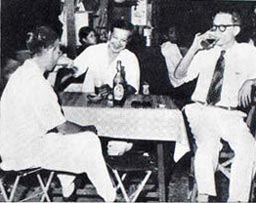
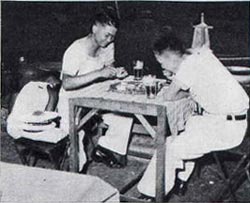
Left: The rich are sometimes Chinese, not adverse to wearing a tie, they speak loudly and a lot.
Right: Vietnamese sailors munch Mekong shrimp while drinking "Molsheim" beer.
During this time, the world of children continues playing, swimming, running, sleeping on the ground on straw mats, on a basket between the rails, on the ground level of the “rollers” or more comfortably on a moored sampan. The children sleep in short naps, awaken, cry or laugh, depending on their age, and go back to sleep.
The night progresses. The guard has stopped guarding – it would be time to grab his sign board to correct the spelling on it. A few steps from there another sign board proclaims rules from another era; life has retaken the advantage over the all-powerful office of customs and excise which prohibit parking.
Life goes on.
The barges of the port cafes leave, but the residents of the docks remain; those of the sampans, those of the junks, those who sleep on the dock, those who live under the piers on a simple plank between the concrete and the muddy water.
At the end of the pier a team of coolies has entered the working world to load a boat made of white wood and with the appearance of a "bateau-mouche". They stuff its belly with beer and nuoc-nam, fuel oil and Vichy water.
Loading the Cape St.-Jacques launch
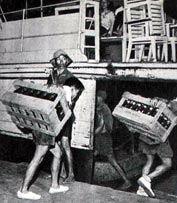

Left: The launch will sail at dawn. "Cai" keeps the night shift going.
Right: "Football" feverishly savaged by ten pairs of wrists, bounces around like a spiritualist’s table. A child’s game, and already a money game.
During this time, the previous team gets into the game: "The Game of Loto" or of "Écarté", in a world where the masters are no longer men but Chance. Chance redistributes the wages of those who have lost, and one after the other, they go off to sleep.
Now the lamp posts of Joker’s Point are extinguished. The Asian way of life reaches its arms out in the shadows and the illuminated top of the Majestic is no more than a boat at anchor, on a river forever unknown.
Bruno Rajan
January 1952

Indochine Sud Est Asiatique (Southeast Asian Indochina)
February, March 1952
Saigon Bureau
95a Somme Boulevard (now HĂ m Nghi).
This special edition was produced to specifically honor Marshal de Lattre de Tassigny who died on January 11th, 1952, in Paris.
In this edition is also an article on the "Cafés of Saigon Harbor" by Bruno Rajan.
The steamship André Lebon

(*) The steamship "André Lebon" was a ship similar to the “Paul Lecat” and the “Sphynx”; it was launched by the shipyard of La Ciotat on October 27th, 1913 and sank in the Singapore harbor in 1919. It was refloated and repaired. On a stopover during the earthquake of September 1st 1923 in Yokohama, she would save more than 1500 people. Decommissioned in Marseille at the end of 1941 by the French Army, she would be seized by the Germans in 1943, and used as a barracks-ship at a dock in Toulon, and would be sunk by an aerial bombing raid on March 11th, 1944.
Refloated in 1945, she would be refitted to accommodate 565 passengers. She would return to the Far-East Line on October 19, 1946 and on August 20th, 1948, would be the first French ship to touch Japan since the war. She would remain in Asiatic service until October 1952, the date of her replacement by new equipment. She was then sold and scrapped at La Seyne in December1952.
This was a year after the publication of Bruno Rajan’s article in the magazine, "Southeast Asian Indochina".
André Lebon was born in Dieppe on October 26th, 1859, and died in Paris on February 17th, 1938. He was a teacher of history and political science, and then became a French man of politics. He was Minister of the Colonies from 1896 to 1898, and then became the administrator of several large companies (Air France, The Suez Canal Company, Crédit Foncier de France, and the Messageries Maritimes). .

Nowadays in Ho Chi Minh City
Left: Joker’s Point was miraculously spared by the construction of a thruway, and seems to miss the old days of the memories of Saigon of yesteryear.
Today, the “Chinese Arroyo” has disappeared...
Right: The Majestic Hotel remains a witness of the history of the dock that was formerly calle the Myre de Villers.


